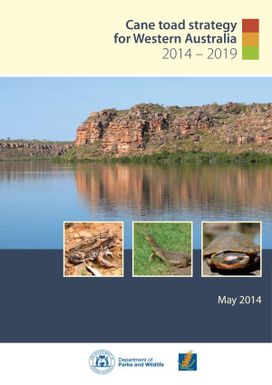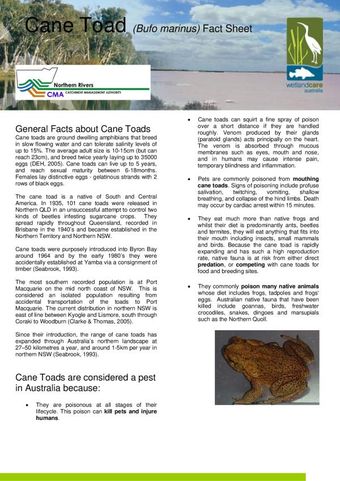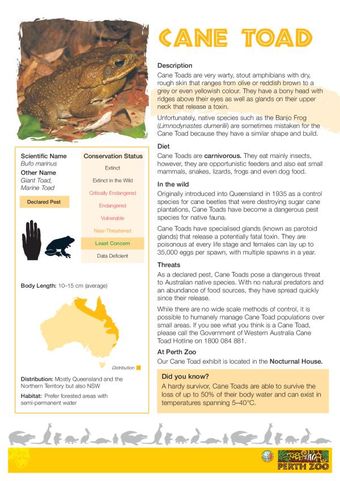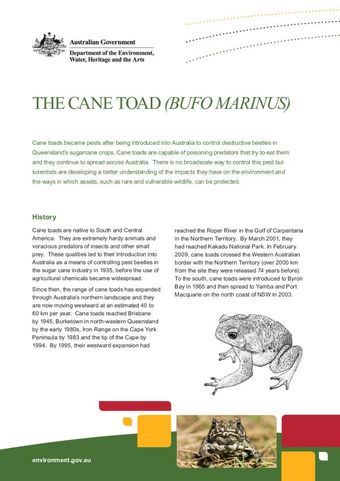Cane toad strategy for Western Australia 2014 to 2019
- Description:
- Cane toads introduced to Queensland in 1935, are major environmental pests in Western Australia, having arrived here in February 2009. The Liberal National Government released a 10-year Cane Toad Strategy for Western Australia in 2009. Over the first five years of the strategy, much has been achieved and the government has invested more than $7.8 million in on ground activities and research to help control the spread of can toads. With a range of stakeholders, including community groups, universities, the Australian Government, local shires, Indigenous groups and others, the State of Government has implemented many new can toad management programs including a field-based cane toad surveillance and response team, strengthened quarantine measures, a free-call hotline to report cane toad sightings and cane toad drop off points. Major biological survey work has provided benchmark information on important island wildlife populations that need priority protection from cane toad. Biological controls are also being researched for the survival of native wildlife species in the short and medium terms and management of cane toads in the longer term. Educating the community has prevented new populations from establishing in Perth and elsewhere. Detector dog specially trained to sniff out cane toads is a proactive measure to stem the spread of this noxious pest. This is a review and update on the original 10 year strategy to review and update the strategy to reflect progress in implementation, the current status of cane toads in WA and results of ongoing research, and to refocus its aims and objectives. Cost effective activities and an integrated approach with other initiatives across WA, such as the $81.5 million Kimberley Science and Conservation Strategy, are required. The revised Cane Toad Strategy for Western Australia 2014-2019 will ensure the available information is used to inform Was continued management of cane toads.
- Collections:
- Secretariat of the Pacific Regional Environment Programme (SPREP)
- Publisher:
- Department of Parks and Wildlife.
- Content partner:
- Secretariat of the Pacific Regional Environment Programme (SPREP)
- Availability:
- Not specified
-
Copyright status: All rights reservedFind out more about what you are able to do with this itemThis item is all rights reserved, with means you'll have to get permission from Secretariat of the Pacific Regional Environment Programme (SPREP) before using it. For more information, please see our use and reuse page.What can I do with this item?Non-infringing useNZ copyright law does not prevent every use of a copyright work, and this item may be hosted by an international institute or organisation. You should consider what you can and cannot do with a copyright work.No sharingYou may not copy and/or share this item with others without further permission. This includes posting it on your blog, using it in a presentation, or any other public use.No modifyingYou are not allowed to adapt or remix this item into any other works.No commercial useYou may not use this item commercially.
Related items
Welcome and warm Pasifik greetings
The information on this site has been gathered from our content partners.
The names, terms, and labels that we present on the site may contain images or voices of deceased persons and may also reflect the bias, norms, and perspective of the period of time in which they were created. We accept that these may not be appropriate today.
If you have any concerns or questions about an item, please contact us.



